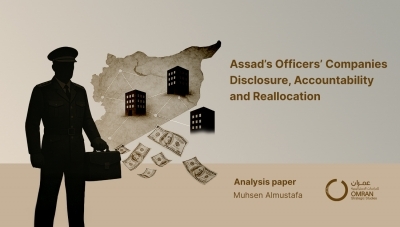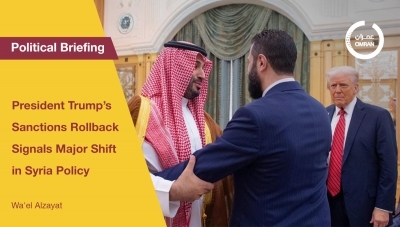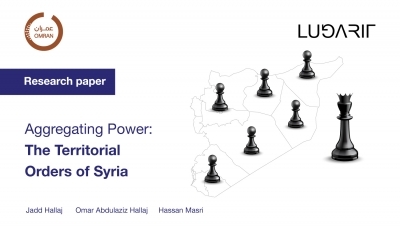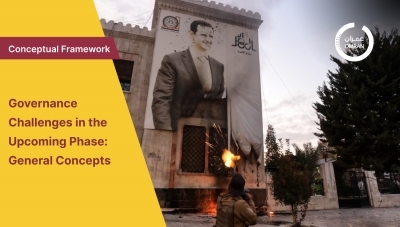Media Appearance
Dr. Ammar Kahf | How important is the conflict in Syria to the EU?
Dr. Ammar Kahf, executive director of the Omran Center for Strategic Studies, commented on the Brussels donor conference, saying, "The pledges were better than expected, except that the focus was always on the aid approach rather than the systematic empowerment approach that the Syrian people need to create more jobs.
For More: https://bit.ly/39vJMvY
Resolution 2254: Feigning Consensus And Postponing the Real Problems
Abstract: The latest UNSC resolution 2254 is a step towards peace in Syria, but not enough for Syrians to celebrate. The resolution delivered a timeframe for the political process; yet it kept explosive issues like the fate of Assad, the sequence of the cease-fire and the political process, the cease-fire imposition and monitoring, and the definition of terrorism, to the upcoming negotiations to defuse. Despite the apparent global consensus, this ambiguity in the resolution reflects significant disagreements within the International Syria Support Group (ISSG) that led to postponing the important issues to be resolved in the nascent peace process. This paper exposes the ambiguous areas in the UNSC resolution 2254, and accordingly it recommends a set of actions to the political and military opposition to best deal with this fragile consensus.
Introduction
On 18 of December 2015, the UN Security Council permanent member states, together with the UN Secretary General Ban Ki Moon, unanimously passed the resolution 2254 on the peace process in Syria. The resolution, proposed by the US, entails a permanent cease-fire through the efforts of the countries of influence on the Syrian regime and opposition. It provides for a peace process based on political pillars including forming an inclusive transitional governing body within 6 months and holding elections within 18 months and drafting a new non-sectarian constitution under UN supervision.
The resolution also features trust-building measures e.g. establishing humanitarian corridors, ensuring safe and swift access for humanitarian organizations to all areas in Syria and releasing all arbitrarily detained persons, especially women and children. Moreover, the resolution calls on all parties to stop any attacks on civilians, utilities and medical and humanitarian teams. It ensures the return of the internally displaced to their homes, rebuilding damaged areas and provide aids to the refugee-hosting countries. The report calls for an expedited report within one month, as of the date of enforcement, by the UN to the Security Council on observance of the resolution provisions.
2254: A Problematic Resolution
The resolution presents a minimum common ground among the regional and international actors, with ambiguous phrasing that is open for multiple interpretations. In its efforts to revive the “hope for a political solution” after fading away in the aftermath of Geneva II meetings, the current resolution is still unclear on many critical issues that might play against the wishes of the international community.
• It fails to name the reference body who would delegate the authority to the Transitional Governing Body (TGB). According to the proposed plan, the initial negotiation phase will result in establishing a TGB with full executive authority. There are two possible delegation mechanisms to the TGB: First, the Security Council gives full authority to the TGB; or, second, Bashar al-Assad as president gives up his authority in favor of the TGB. In such an intractable situation, the latter option is unlikely and the former is yet problematic. The ambiguity of this provision is a potential point of contestation during the upcoming negotiations.
• The ambiguity of the future of Assad’s creates tensions and spreads distrust in interpreting all the provisions of the resolution. The latter failed to specify Assad’s role during and post-transition, due to the international dissent on the issue. Leaving Assad’s fate to the direct negotiations risks collapsing the whole process should the negotiating parties fail to reach a consensus.
• It casts doubt on the inclusiveness of the outcome of the Riyadh-- the Supreme Negotiation Committee-- by noting Moscow and Cairo efforts. This statement clearly questions the exclusiveness of the Supreme Negotiation Committee representation, and “prepare the terrain” to a non-organic expansion of the SNC.
• It leaves the sequence of the cease fire and the political process fairly vague. The resolution recognizes the close linkage between a nationwide cease-fire in Syria and the political process, but it describes the CFA as “a parallel track” occurring when initial steps are taken towards a political transition. Multiple interpretations might arise out of this blurriness. Specifically, the opposition will resist a cease fire before reaching a consensus on the main issues.
• It lacks specific mechanisms to monitor the cease-fire. The Secretary General was assigned to provide the ‘available’ options within a month at the latest. The recent history of the UN’s failure to set a mechanism to form an international monitoring team as part of Anan’s Six Point plan allows impractical options such as assigning local monitoring teams from the civil society and institutions representing both parties to the conflict. The lack of mechanisms to ensure adherence to the political process or the cease-fire and punish the violators, the Assad regime has no incentives to commit.
• It lacks trust building measures necessary to start negotiations on good faith. These include end of the indiscriminate use of force against civilians, including barrel bombs, allow aid convoys access without restrictions or pre-conditions, end attacks on medical and educational facilities, lift all restrictions on medical supplies provided by humanitarian convoys and releasing all detainees.
• It adopts unclear criteria and definition of terrorism and in-transparent mechanism of naming terrorist organizations. Such vagueness grants the International Syria Support Group (ISSG) the ability to use terrorist group designation to pressure revolutionary forces; that shrinks spaces of confidence on the part of the opposition, thus reduces their willingness to participate in the political process.
In a thorough evaluation, it can be argued that the Security Council has failed in solving the post-Vienna dilemmas and maintained the international disagreement on their interpretations. It, however, only succeeded in adopting a timetable for the political process, yet without setting any implementation mechanisms.
Political and Military Recommendations
The negotiations committee cannot afford to reject a new round of negotiations with the regime, despite the lack of international guarantees for a serious political process. The insistence of the Security Council on the need to pursue the Vienna course indicates that the international community is keen on bringing the opposition and the regime to the negotiating table next January. Therefore, the opposition has to proceed with a clear strategy consistent with the demands of the revolution, in close coordination with the National Coalition and the military actors. The negotiation committee should present the view of the Syrian opposition on the problematic issues in the resolution and the best mechanisms to engage with them. The following are some suggested points:
1. Demand that Security Council to be the sole guarantor of the political process in general and the only authorized entity to grant full executive powers to the Transitional Governing Body (TGB).
2. Set the departure of Assad as concurrent with the declaration of the interim governing body. And ask for international guarantees to ensure the prevention of Assad from running for any political office during and post-transition period.
3. Adopt the Riyadh Communique that has established the negotiation committee as a prerequisite for its expansion, due to either international requests or needs of the political process.
4. Insist on assigning international observer mission and hold the UN responsible for the enforcement of the agreement to ensure the documentation of any breaches by the regime. Moreover, local truces should not substitute a nation-wide cease-fire agreement. Any initial agreement shall not be binding unless adopted by a Security Council resolution until the interim governing body is formed. Hereby a tentative framework for enforcing the cease-fire:
5. Suggest that local councils monitor the cease-fire should the UN is unable to be present due to security or logistical reasons. For that to be feasible, demand adequate training for local observers on monitoring cease-fire with the help of the UN.
6. Mobilize the Friends of Syria countries on joint positions regarding the controversial issues in the SC resolution. This could be achieved through political and diplomatic efforts by the Negotiations Committee and the convening political and military bodies. Syria friends countries should advocate the policies and negotiation stands of the committee and lobby them in the international organizations. No effort should be bared, including media campaigns to highlight the basic demands of the revolution and ensure they are not waived regardless of the political or military circumstances.
The armed patriotic revolutionary groups should take the following measures:
1. Pursue strategic military operations without being compelled by a potential cease-fire. Military mobilization and alertness should be heightened in case a cease-fire is enforced.
2. Form a military force for urgent interventions, with the participation of all national opposition forces, in order to contain any brigades failing under international pressures. This military force shall deter the regime in case of any breach to the cease-fire.
3. Oust the Islamic State (ISIS) of northern Aleppo, as a step for a total liberation of the city. ISIS should also be totally alienated in southern Syria.
4. Maintain border checkpoints with Turkey and Jordan, and manage it by a specialized civil entity with the support of a central military force.
5. Suspend all bilateral talks with the regime regarding local truces. All ceasefire agreements should be held only for temporary periods and humanitarian relief only.
Conclusion
Doubtlessly, the resolution enhances the mechanisms and outcomes of the Vienna process, where agreements and deliverables are included in the resolution. On the other hand, it affirms the key Russian role in steering the process and formulating a favorable end to its interests. The resolution masterfully avoids the Russian and American disagreements on interpreting the Geneva I Communiqué. These countries provided separate interpretations of the document and bought time to retrieve and manipulate them. The UNSC 2254 resolution clearly represents the dominance of the Russian interpretations of the Geneva I communique.
Though the new resolution sets a timetable for an immature political process, it yet again proves the helplessness of the international system for the Syrian cause. The preconditions of the Russians, that do not fall in line with the calls and demands of the Syrians, are fully taken into consideration. The resolution is based on postponing the issues that would have a significant impact on the process and its mechanisms. This can be demonstrated through the numerous holes in the resolution: the terms of cease-fire, ignoring terrorism acts of the regime and its allies, and the silence over transitional justice mechanisms.




